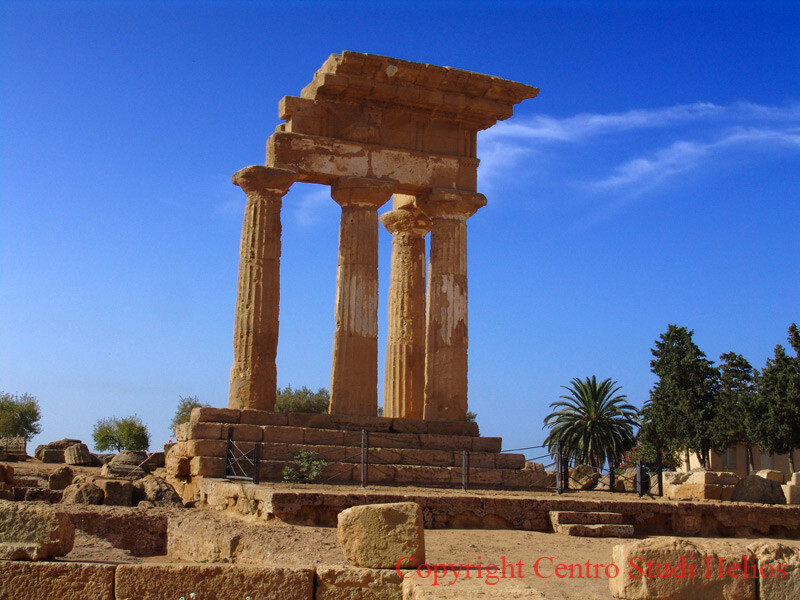I Dioscuri (Castor and Pollux)
The following is excerpted from: Cults, Myths and Legends of Ancient Sicily (Author: Ignazio Caloggero - ISBN: 9788894321913)
The Dioscuri at the Campidoglio - Rome
Origins of the MIto
Dioscuri (from Dioskuroi that is "children of God") is the name by which Castor and Pollux are known, children of Zeus need Leda, the wife of Tindaro, king of Lacedaemon. The night in which the Dioscuri were conceived, Leda also joined her husband and from that night of love, in addition to Castor and Pollux, were also born Elena e Clytemnestra. There was disagreement among the ancients to establish which of the children was born from the seed of the god and which, instead, from that of Tindaro. Eventually they attributed themselves to Zeus, Pollux and Elena who were therefore considered immortal, and to Tindaro, Castor and Clytemnestra, considered mortal.
The two brothers were also called Tindaridi, or sons of Tindaro.
Castor is seen as a very good horse tamer and Pollux is considered an excellent boxer.
Their legend is characterized by the great brotherly love that bound them in life and which lasted even after death. They were inseparable friends and when, as a result of an ambush, Castor was killed and Pollux wounded, Zeus called with him Pollux to Olympus, he refused immortality if the same fate had not also befallen his brother Castor. Zeus, struck by this brotherly love, promised them to keep them always together, one day in Olympus and one day underground, in the Underworld. The two heroes, made immortal, are then seen living for ever in both light and darkness.
The Dioscuri, as well as the natives stakes, were considered protectors of people who were in danger, were invoked in battle or during a strong storm and were particularly revered by sailors. It is no coincidence that the two-pointed fireworks of Sant'Elmo [1] were called "Dioscuri", which were considered a good omen by sailors.
Roman coin representing the Roman emperor Marcus Aurelius Valerius Maxentius (278-312) and the Dioscuri
The Myth in Sicily
In Sicily the cult of the Dioscuri absorbed the indigenous cult of the Palici. To Agrigento, the remains of a temple of the fifth century have been found. BC, perhaps dedicated to them [2], where the Theoxenie were celebrated, feasts in which it was believed that the Dioscuri participated in the public banquet by making, with this action, a pact of alliance with the participants [3].
Temple of Castor and Pollux - Agrigento
It is probable that the cult of the Dioscuri also existed in Tindari. The name of the city itself derives, in fact, from Tindaridi, a name with which the Dioscuri were also known. In fact, a representation of the Dioscuri in a black and white mosaic was found in a room inside a thermal building in Tindari, probably from the second century, which came to light from excavations that took place after 1949.
The discovery of coins would indicate the presence of the cult also a SIRACUSA, Catania e Palermo [4].
The archaeological findings of recent years have also shown the existence of the cult of the Dioscuri in the cities of Solunto [5], where a panel representing them was found [6], and by Akray [7] where two statues representing the deities were found [8].
Religious syncretism
Even for the Dioscuri there is no lack of links with the saints of Christianity. They contributed, together with Asclepius, to form the image of the saints Cosimo and Damiano, the two medical brothers martyred in the third century. and then hired as protectors of the sick. Analyzing the origin of the name Damiano, it can be seen that it derives from the Greek "Damasos " which means "tamer", and a skilled tamer was Castor, one of the Dioscuri brothers. The Dioscuri were protectors of the people of the sea and in Sicily, a Palermo, even the saints, Cosimo and Damiano were considered protectors of fishermen. In the last century the feast of the saints, Cosimo and Damiano in Palermo had been canceled, it is said for reasons of public safety, and it was precisely the fishermen who, by putting pressure on the authorities, managed, in 1894, to restore the feast.
Santi Cosma e Damiano
In this regard, see the interesting article by Roberto Garufi published online on Slow Food Palermo [10]
[1] The Fires of St. Elmo probably had an electrostatic origin, in fact, it happened to see them at the top of the masts of ships during strong storms and, somehow, they were an indication that the storm was about to end.
[2] Vincenzo Tusa and Ernesto De Miro: Western Sicily p.131.
[3] Ciaceri Emanuele: Cults and Myths of Ancient Sicily p.296.
[4] Ciaceri Emanuele: Cults and Myths of Ancient Sicily p.301.
[5] The remains of the ancient center were located near Monte Catalfano (about 16 km east of Palermo).
[6] Filippo Coarelli and Mario Torelli: Sicily “Archaeological Guides Laterza” p.38.
[7] The ancient Greek center has been identified near Palazzolo Acreide in the province of Syracuse.
[8] Filippo Coarelli and Mario Torelli: Sicily “Archaeological Guides Laterza” p.298.
[9] Roberto Garufi: "U Viaggiu di Cosma e Damiano" link: https://slowfoodpalermo.com/2013/09/29/u-viaggiu-di-cosma-e-damiano-di-roberto-garufi/
Card insertion: Ignazio Caloggero
Photo: web, Ignazio Caloggero
Information contributions: Ignazio Caloggero, Region of Sicily







